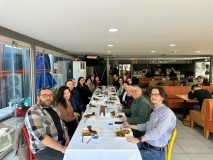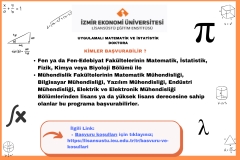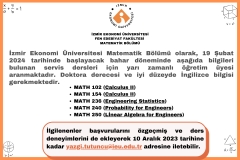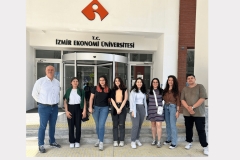
FACULTY OF ARTS AND SCIENCES
Department of Mathematics
GEAR 212 | Course Introduction and Application Information
| Course Name |
Basic Photography
|
|
Code
|
Semester
|
Theory
(hour/week) |
Application/Lab
(hour/week) |
Local Credits
|
ECTS
|
|
GEAR 212
|
Fall/Spring
|
2
|
2
|
3
|
6
|
| Prerequisites |
None
|
|||||
| Course Language | ||||||
| Course Type |
Second Foreign Language
|
|||||
| Course Level |
-
|
|||||
| Mode of Delivery | - | |||||
| Teaching Methods and Techniques of the Course | DiscussionQ&ACritical feedbackApplication: Experiment / Laboratory / WorkshopLecture / Presentation | |||||
| Course Coordinator | ||||||
| Course Lecturer(s) | ||||||
| Assistant(s) | - | |||||
| Course Objectives | The main objective of the course is to develop a working knowledge of photography through the application of skills regarding camera choices, lens choices, camera operation (aperture/shutter speed/ISO), lighting, composition and image processing. Through a series of genre-oriented assignments, students will learn to shoot and edit according to assignments/client briefs. |
| Learning Outcomes |
The students who succeeded in this course;
|
| Course Description | Through bi-weekly assignments, students are expected to produce photographs according to the demands/technical requirements of the following genres: street photography, architectural photography, product photography, and fashion photography. |
|
|
Core Courses | |
| Major Area Courses | ||
| Supportive Courses | ||
| Media and Management Skills Courses | ||
| Transferable Skill Courses |
WEEKLY SUBJECTS AND RELATED PREPARATION STUDIES
| Week | Subjects | Related Preparation |
| 1 | Introduction | |
| 2 | History of Photography & Photography Basics | Davenport, A., 1991, The History of Photography, Focal Press: Boston, ISBN: 0-8263-2076-7 p.3-29. Turner, P., 1987, History of Photograph, Bison Books Corp: USA, ISBN: 0-671-08923-4, p. 11-35. Stuckey, S., National Geographic Complete Photography, 2011, National Geographic Society: USA, ISBN: 978-142620776, p. 9-196. |
| 3 | Photography Basics II & Assignment | Diprose, G. and Robins, J., 2012, Photography: the new basics: principles, techniques and practice, Thames&Hudson: United Kingdom, ISBN: 978-0-500-28978-5, p. 45-68 and p.113-140. |
| 4 | Project I (%10) Change your angle! | |
| 5 | Project I Continues & Adobe Camera Raw Workshop | Sheppard, R., 2008, Adobe Camera Raw For Digital Photographers Only, 2nd ed., Wiley Publishing: Indiana, ISBN: 978-0-470-22457-1, p.73-266. |
| 6 | Project II (%10) Portrait Photography & Basics of Photostudio Equipment | Child, J. , Studio Photography Essential Skills, 2008, 4th ed., Focal Press: Canada, ISBN: 978-0-240-52096-4, p. 45-126 Lewinski, J. and Magnus, M., The Book of Portrait Photography, 1982, Alfred A. Knopf Inc. : New York, ISBN: 978-0394524689, p.6-72 Smith, B., Secrets of Great Portrait Photography: Photographs of the Famous and Infamous, 2013, New Riders: USA, ISBN: 978-0-321-80414-3, p. 18-194 |
| 7 | Project II Continues | |
| 8 | Project III (%10) Indoor & Outdoor Fashion Photography | Siegel, E, 2008, The Fashion Photography Course: First Principles to Successful Shoot - the Essential Guide, Thames&Hudson: London, ISBN: 978-0-500-28769-9, p.10-99. |
| 9 | Project III Continues | - |
| 10 | Project IV (%10) Still Life Photography | Perweiler, G., 1984, Secrets of Studio Still Life Photography, Amphoto: New York, ISBN: 0-8174-5898-0, p.6-133 |
| 11 | Project IV Continues & Project V (%10) A day in your life | - |
| 12 | Photoshoot Event | |
| 13 | Project V Continues | |
| 14 | Project V Continues & Portfolio Submission Brief | |
| 15 | Semester Review | Portfolio Submission |
| 16 | Semester Review |
| Course Notes/Textbooks | |
| Suggested Readings/Materials | Davenport, A., 1991, The History of Photography, Focal Press: Boston, ISBN: 0-8263-2076-7 p.3-29 Turner, P., 1987, History of Photograph, Bison Books Corp: USA, ISBN: 0-671-08923-4, p. 11-35 Stuckey, S., National Geographic Complete Photography, 2011, National Geographic Society: USA, ISBN: 978-142620776, p. 9-196 Diprose, G. and Robins, J., 2012, Photography: the new basics: principles, techniques and practice, Thames&Hudson: United Kingdom, ISBN: 978-0-500-28978-5, p. 45-68 and 113-140 Sheppard, R., 2008, Adobe Camera Raw For Digital Photographers Only, 2nd ed., Wiley Publishing: Indiana, ISBN: 978-0-470-22457-1, p.73-266 Lewinski, J. and Magnus, M., The Book of Portrait Photography, 1982, Alfred A. Knopf Inc. : New York, ISBN: 978-0394524689, p.6-72 Smith, B., Secrets of Great Portrait Photography: Photographs of the Famous and Infamous, 2013, New Riders: USA, ISBN: 978-0-321-80414-3, p. 18-194 Child, J. , Studio Photography Essential Skills, 2008, 4th ed., Focal Press: Canada, ISBN: 978-0-240-52096-4, p. 45-126 Siegel, E, 2008, The Fashion Photography Course: First Principles to Successful Shoot - the Essential Guide, Thames&Hudson: London, ISBN: 978-0-500-28769-9, p.10-99 Perweiler, G., 1984, Secrets of Studio Still Life Photography, Amphoto: New York, ISBN: 0-8174-5898-0, p.6-133 |
EVALUATION SYSTEM
| Semester Activities | Number | Weigthing |
| Participation |
1
|
10
|
| Laboratory / Application | ||
| Field Work | ||
| Quizzes / Studio Critiques | ||
| Portfolio |
1
|
30
|
| Homework / Assignments |
1
|
10
|
| Presentation / Jury | ||
| Project |
1
|
50
|
| Seminar / Workshop | ||
| Oral Exams | ||
| Midterm | ||
| Final Exam | ||
| Total |
| Weighting of Semester Activities on the Final Grade |
4
|
100
|
| Weighting of End-of-Semester Activities on the Final Grade | ||
| Total |
ECTS / WORKLOAD TABLE
| Semester Activities | Number | Duration (Hours) | Workload |
|---|---|---|---|
| Theoretical Course Hours (Including exam week: 16 x total hours) |
16
|
2
|
32
|
| Laboratory / Application Hours (Including exam week: '.16.' x total hours) |
16
|
2
|
32
|
| Study Hours Out of Class |
14
|
2
|
28
|
| Field Work |
0
|
||
| Quizzes / Studio Critiques |
0
|
||
| Portfolio |
1
|
28
|
28
|
| Homework / Assignments |
1
|
10
|
10
|
| Presentation / Jury |
0
|
||
| Project |
5
|
10
|
50
|
| Seminar / Workshop |
0
|
||
| Oral Exam |
0
|
||
| Midterms |
0
|
||
| Final Exam |
0
|
||
| Total |
180
|
COURSE LEARNING OUTCOMES AND PROGRAM QUALIFICATIONS RELATIONSHIP
|
#
|
Program Competencies/Outcomes |
* Contribution Level
|
||||
|
1
|
2
|
3
|
4
|
5
|
||
| 1 | To be able to have a grasp of basic mathematics, applied mathematics or theories and applications of statistics. |
|||||
| 2 | To be able to use advanced theoretical and applied knowledge, interpret and evaluate data, define and analyze problems, develop solutions based on research and proofs by using acquired advanced knowledge and skills within the fields of mathematics or statistics. |
|||||
| 3 | To be able to apply mathematics or statistics in real life phenomena with interdisciplinary approach and discover their potentials. |
|||||
| 4 | To be able to evaluate the knowledge and skills acquired at an advanced level in the field with a critical approach and develop positive attitude towards lifelong learning. |
|||||
| 5 | To be able to share the ideas and solution proposals to problems on issues in the field with professionals, non-professionals. |
|||||
| 6 | To be able to take responsibility both as a team member or individual in order to solve unexpected complex problems faced within the implementations in the field, planning and managing activities towards the development of subordinates in the framework of a project. |
|||||
| 7 | To be able to use informatics and communication technologies with at least a minimum level of European Computer Driving License Advanced Level software knowledge. |
|||||
| 8 | To be able to act in accordance with social, scientific, cultural and ethical values on the stages of gathering, implementation and release of the results of data related to the field. |
|||||
| 9 | To be able to possess sufficient consciousness about the issues of universality of social rights, social justice, quality, cultural values and also environmental protection, worker's health and security. |
|||||
| 10 | To be able to connect concrete events and transfer solutions, collect data, analyze and interpret results using scientific methods and having a way of abstract thinking. |
|||||
| 11 | To be able to collect data in the areas of Mathematics or Statistics and communicate with colleagues in a foreign language. |
|||||
| 12 | To be able to speak a second foreign language at a medium level of fluency efficiently. |
|||||
| 13 | To be able to relate the knowledge accumulated throughout the human history to their field of expertise. |
|||||
*1 Lowest, 2 Low, 3 Average, 4 High, 5 Highest
NEWS |ALL NEWS
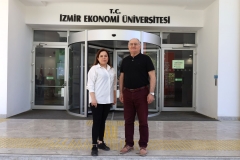
International success in mathematics
Spain-based ranking organization Scimago Institutions Ranking ranked IUE Department of Mathematics as 261st in the world and second in our country, as a
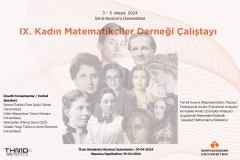
9th Workshop of Association for Turkish Women in Maths
9th Workshop of Association for Turkish Women in Maths will take place from May 03 to May 05, 2024 in Izmir, Turkey,
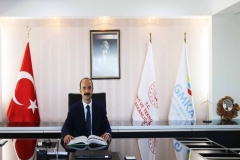
Our 2009 Graduate Has Been Appointed to the South Marmara Development Agency (GMKA) as the General Secretary
Onur Adıyaman, General Secretary of the Eastern Black Sea Development Agency, appointed as the General Secretary of the South Marmara Development Agency.
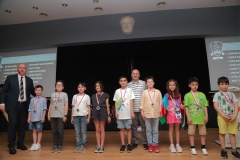
Young mathematicians came together at IUE
The award ceremony of the Turkish Mathematical Olympiad, which is organized to increase the interest of primary, secondary and high school students




